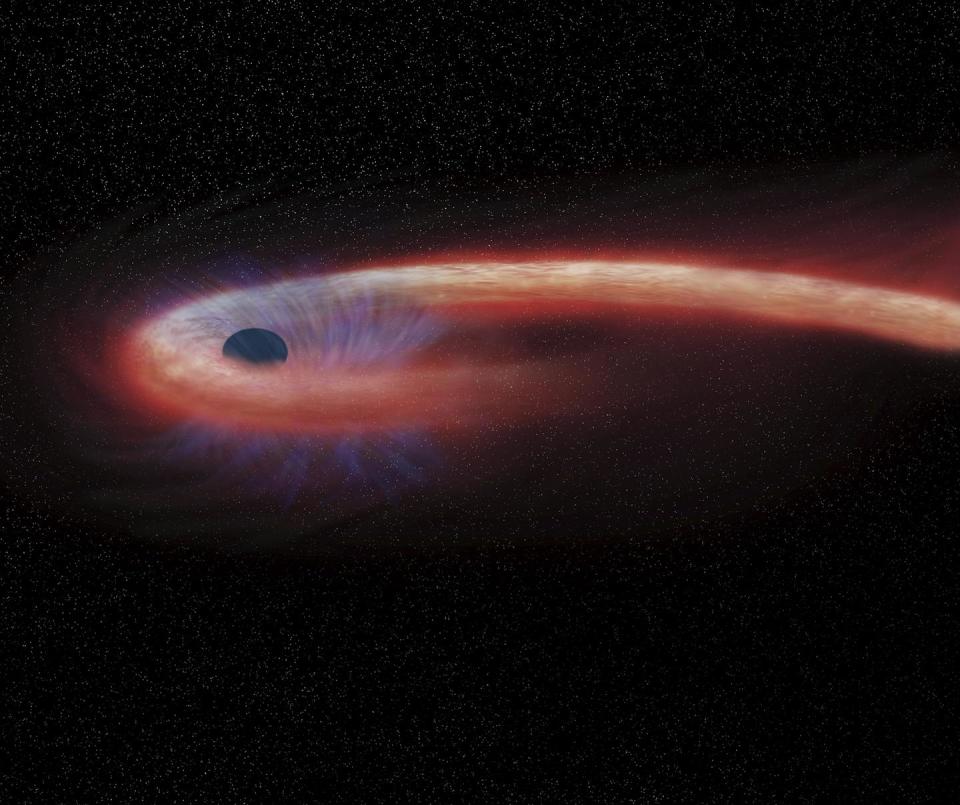About a trillion tiny particles called neutrinos pass through you every second. These ‘relict’ neutrinos were created during the Big Bang and exist throughout the universe, but they can’t hurt you. In fact, it’s likely that just one of them will lightly tap an atom in your body throughout its entire life.
Most neutrinos produced by objects such as black holes have much more energy than the relic neutrinos floating through space. Although much rarer, these energetic neutrinos are more likely to collide with something and create a signal that physicists like me can detect. But to detect them, neutrino physicists have had to build very large experiments.
IceCube, one such experiment, documented a particularly rare type of particularly energetic astrophysical neutrinos in a study published in April 2024. These energetic neutrinos often masquerade as other, more common types of neutrinos. But for the first time, my colleagues and I managed to detect them, pulling a few from nearly a decade of data.
Their presence brings researchers like me one step closer to unraveling the mystery of how high-energy particles like astrophysical neutrinos are produced in the first place.
IceCube Observatory
The IceCube Neutrino Observatory is the 800-pound gorilla of large neutrino experiments. It has about 5,000 sensors that have been peering intently at a gigaton of ice beneath the South Pole for more than a decade. When a neutrino collides with an atom in the ice, a ball of light is created that is registered by the sensors.
IceCube has detected neutrinos originating in various places, such as Earth’s atmosphere, the center of the Milky Way, and black holes in other galaxies many light-years away.
But the tau neutrino, a type of particularly energetic neutrino, has so far eluded IceCube.
Neutrino flavors
Neutrinos come in three different types, which physicists call flavors. Each flavor leaves a clear imprint on a detector such as IceCube.
When a neutrino collides with another particle, it usually produces a charged particle that matches its flavor. A muon neutrino produces a muon, an electron neutrino produces an electron, and a tau neutrino produces a tau.
Muon-flavored neutrinos have the most distinctive signature, so my colleagues and I in the IceCube collaboration naturally looked for those first. The muon emitted in a muon-neutrino collision will travel through hundreds of meters of ice, forming a long trail of detectable light before decaying. This trail allows researchers to trace the origin of the neutrino.
The team next looked at electron neutrinos, whose interactions produce a roughly spherical ball of light. The electron produced by a collision with electron neutrinos never decays and collides with every particle in the ice it comes near. This interaction leaves behind an expanding ball of light before the electron finally comes to rest.
Because the direction of the electron neutrino is very difficult to discern by eye, IceCube physicists used machine learning techniques to point back to where the electron neutrinos may have originated. These techniques use advanced computing resources and tune millions of parameters to separate neutrino signals from all known backgrounds.
The third flavor of neutrino, the tau neutrino, is the chameleon of the trio. One tau neutrino may appear as a trail of light, while the next may appear as a ball. The tau particle created in the collision only travels for a fraction of a second before decaying, and when it decays it usually produces a ball of light.
Those tau neutrinos create two orbs: one where they initially collide with something and create a tau, and one where the tau itself decays. Typically, the tau particle decays after traveling only a very short distance, causing the two orbs to overlap so much that they become indistinguishable from a single ball.
But at higher energies, the emitted tau particle can travel tens of meters, resulting in two orbs of light that are separated from each other. Physicists armed with these machine learning techniques can see through this and find the needle in the haystack.
Energetic tau neutrinos
Using these computational tools, the team managed to extract seven strong candidate tau neutrinos from about a decade of data. These taus had higher energies than even the most powerful particle accelerators on Earth, meaning they must have come from astrophysical sources such as black holes.
These data confirm IceCube’s previous discovery of astrophysical neutrinos, and they confirm a clue IceCube previously picked up about astrophysical tau neutrinos.
These results also suggest that even at the highest energies and over large distances, neutrinos behave much the same as at lower energies.
In particular, the detection of astrophysical tau neutrinos confirms that energetic neutrinos from distant sources change flavor or oscillate. Neutrinos with much lower energies that travel much shorter distances also oscillate in the same way.

As IceCube and other neutrino experiments collect more data and scientists become better at distinguishing the three neutrino flavors, researchers will eventually be able to guess how neutrinos coming from black holes are produced. We also want to find out whether the space between Earth and these distant astrophysical neutrino accelerators treats particles differently depending on their mass.
There will always be fewer energetic tau neutrinos and their muon and electron relatives compared to the more common neutrinos that come from the Big Bang. But there are enough of them to help scientists like me search for the most powerful neutrino emitters in the universe and study the limitless space between them.
This article is republished from The Conversation, an independent nonprofit organization providing facts and trusted analysis to help you understand our complex world. It was written by: Doug Cowen, Penn State
Read more:
Doug Cowen receives funding from the National Science Foundation.